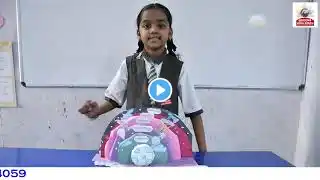
SATELLITE SCIENCE FAIR PROJECT WORK | GOUTHAM GLOBAL SCHOOL #camritz #goutham #queens
Project Title: "Exploring the World of Satellites: How They Help Us Understand Our Planet" Description: This project will focus on understanding satellites, their types, functions, and how they are used for scientific, military, commercial, and communication purposes. You will learn about the technology behind satellites, how they are launched into space, and the roles they play in providing vital data for Earth and space exploration. You may also explore different satellite types such as communication satellites, weather satellites, Earth observation satellites, and GPS satellites. Steps: Research: Types of Satellites: Research the different types of satellites, including: Communication Satellites: Used for television, internet, and radio communication. Weather Satellites: Monitor weather patterns, track storms, and predict weather. Earth Observation Satellites: Capture images and data of the Earth for environmental monitoring, land mapping, and disaster response. GPS Satellites: Help with navigation and positioning for both civilian and military purposes. Satellite Orbits: Learn about different orbits used by satellites, such as geostationary orbit, low Earth orbit (LEO), and medium Earth orbit (MEO). Launch Process: Understand how satellites are launched into space, including the use of rockets, and the technologies involved in getting them into orbit. Satellite Components: Study the key components of a satellite, such as power sources (solar panels), communication systems, and sensors used for gathering data. Hypothesis: Hypothesize how satellites in different orbits can affect the quality of data received by Earth-based stations. For example, you might predict that weather satellites in geostationary orbit can provide better continuous monitoring than those in low Earth orbit. Experiment or Activity: Build a Model Satellite: Create a basic model of a satellite using common materials (e.g., a plastic ball for the satellite body and small wires or paper for the solar panels). This can demonstrate the basic components of a satellite. Simulate Satellite Communication: Set up a simple communication system using a radio or walkie-talkie. Show how signals can be sent and received between Earth and a satellite (even on a small scale). Satellite Orbit Simulation: Use a spinning globe and small objects to represent satellites. Demonstrate how objects move in different orbits and how this affects their ability to collect data from different parts of the Earth. Weather Satellite Simulation: Simulate how weather satellites track storm patterns or weather changes. You can use a basic computer program or map to track a "satellite" as it moves across a grid representing the Earth and observe weather changes. Data Collection: Record the data you collect during your experiments. For example, if you’re simulating satellite communication, you could track the clarity of the signal at different distances. If you build a model satellite, measure how long it takes to complete an orbit (simulating a satellite’s orbit around Earth). Conclusion: Analyze your results and determine how different satellite systems contribute to Earth-based technology and services. Discuss the importance of satellites in modern life, such as how GPS helps with navigation, how weather satellites improve forecasting, and how communication satellites keep the world connected. Reflect on the future of satellites in space exploration and Earth observation, including emerging technologies like satellite constellations and space tourism. #Satellites #SpaceScience #CommunicationSatellites #WeatherSatellites #GPS #SatelliteTechnology #ScienceFair #SatelliteOrbits #SpaceExploration #EarthObservation #SpaceTechnology #SatelliteModels #SatelliteData #GlobalNavigation #WeatherForecasting #SpaceScienceProjects #SatelliteLaunch #SatelliteSystems







